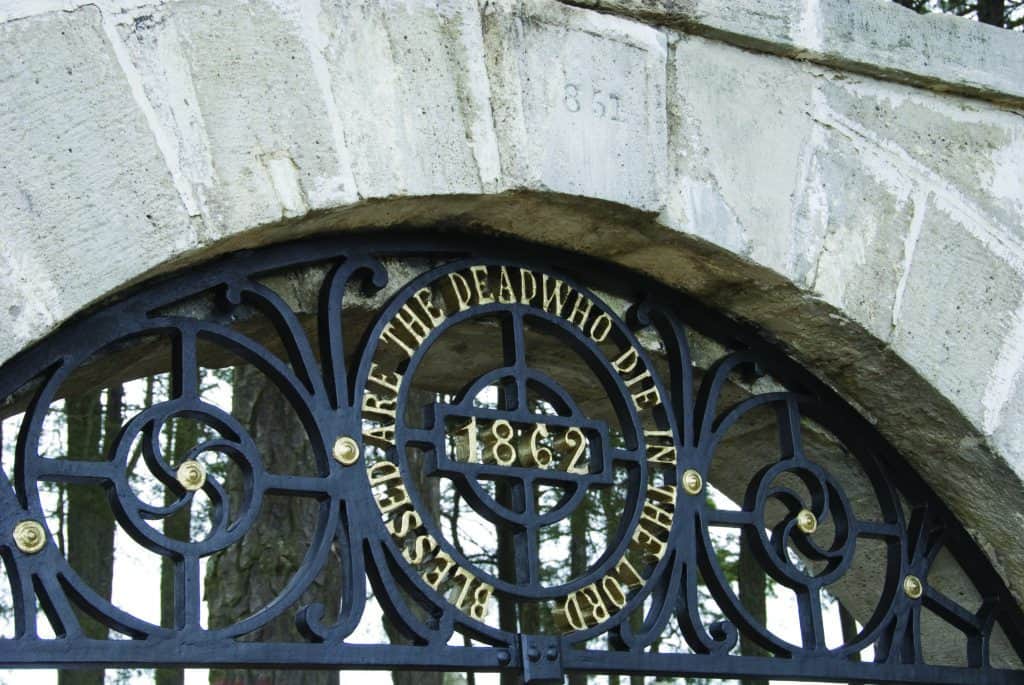
Some corner of a foreign field that is forever Cornwall:
The Vials of Camborne
Just recently I was delighted to discover that I am distantly related to John Edgar Benjamin Vial (1894-1916), who died on active service in France during the First World War. Although he is interred in France, because he was born in Pachuca, Mexico, he is memorialised on his mother’s grave in the Panteón Inglés de Mineral del Monte (English Cemetery, Real del Monte). I have been researching and publishing on the Cornish in Latin America for almost three decades, and have wandered round this cemetery several times, passing the memorial in question without ever realising that those buried there were related to me.
Lately, I have been using Ancestry to do some research on my maternal grandfather, Harry Polkinghorne’s family. His grandmother was Ann Trythall, born in Illogan parish in 1830. I discovered that Ellen Trythall, born to Benjamin Trythall and Elizabeth Faull at Ramsgate, Camborne in 1858, married James Vial in Camborne in 1880. The unusual name Vial rang a bell and I consulted my database to find that one James Vial was buried at the English Cemetery in Real del Monte. Could it be the same man? It turned out that it was…
A Trythall of History
I instantly knew that I probably had a relationship to Ellen Trythall, for all of the Trythalls in Camborne and district are almost undoubtedly descended from two brothers: John (born in 1726) and Sampson (b.1728), the sons of Sampson Trythall and Katherine Cock.
The surname Trythall, also spelt ‘Trithall’ and variants, comes from the Cornish ‘tre’, meaning farm or settlement, and the personal name, ‘Gwrethal’, with the meaning Gwrethal’s farm (the ‘g’ is dropped). It is first recorded as Trevrythall in the Parish of Gulval in 1457. Trythall Manor Farm is located near Newmill, which is just over 3km to the north of Penzance.
The first bearers of the Trythall surname appear in the 1522 Cornwall Military Survey (John Trewrythall and William Trerythall of Gulval), while William Treythall of Gulval is recorded in the 1525 Subsidy Rolls. A Counterpart of demise (E 40/13004 National Archives, Kew) dated 6 June 1564 by Thomas Tretherfe of Tremayne, Esq, mentions John Trythall and others in relation to of all his land, etc. at Trethogga veor and Barlowena in the parish of Gulvall.
A mere three years after the Gulval parish baptismal register was opened, the surname appears: ‘Richardus filius Henrici Trithall’ (Aprilis 1601). The Trythall surname is therefore almost certainly indigenous to Gulval and it ramifies strongly there. It was from this area that John and Sampson migrated eastwards to Camborne in the mid-eighteenth century. Camborne was then a fast-developing mining parish, and their migration was undoubtedly connected to labour opportunities in the burgeoning copper mines.
Both men married Camborne women: John wed Elizabeth Yeats in 1751 and Sampson wed Blanche Rowe in 1753. My great great grandmother, Ann Trythall, is descended from John and Elizabeth’s branch of the family, and I discovered that Ellen is descended from Sampson and Blanche’s line. Ann and Ellen shared a common ancestor in Samson Trythall, so my relationship to John Edgar Benjamin Vial is very distant, but the old adage, All Cornish are Cousins, certainly rings true!
The Vials of Camborne
I was intrigued by John Vial’s life and death, so decided to try and find out a little more about he and his family. His father was James Vial, born in 1860 to copper miner, Samuel Vial (1823-1882) and his wife, Caroline Thomas, who were from Tuckingmill. As a one-year-old, Samuel was living with his parents and five older siblings at Lower Centenary Street, a terrace of humble miners’ cottages in one of Camborne’s main throughfares. The family was obviously poor, as James’s nine-year-old brother, Stephen, was already working at one of the mines.
By 1871, the family had moved to similar premises at nearby Carnarthen Street. James was no longer the baby of the family; he had been joined by three younger siblings. The family’s circumstances had improved to the point that James had not been sent to the mines to work, but was still at school. His older sisters, Elizabeth and Caroline, were noted as ‘at home’, so had not been forced to seek work on the surface of the mines as ore dressers (bal maidens) to contribute to the family’s collective income, as was customary among the Cornish mining class. The household was being sustained by the wages of his father Samuel and older brothers, Stephen and Samuel, who were working as miners.
On 4 April 1880, James, then aged 21, married Ellen Trythall at Camborne Church. She was the same age as him and both had been living at Rosewarne Road, Camborne. James was working as a miner and she was employed as a factory girl. This was possibly at one of the nearby safety fuse works.
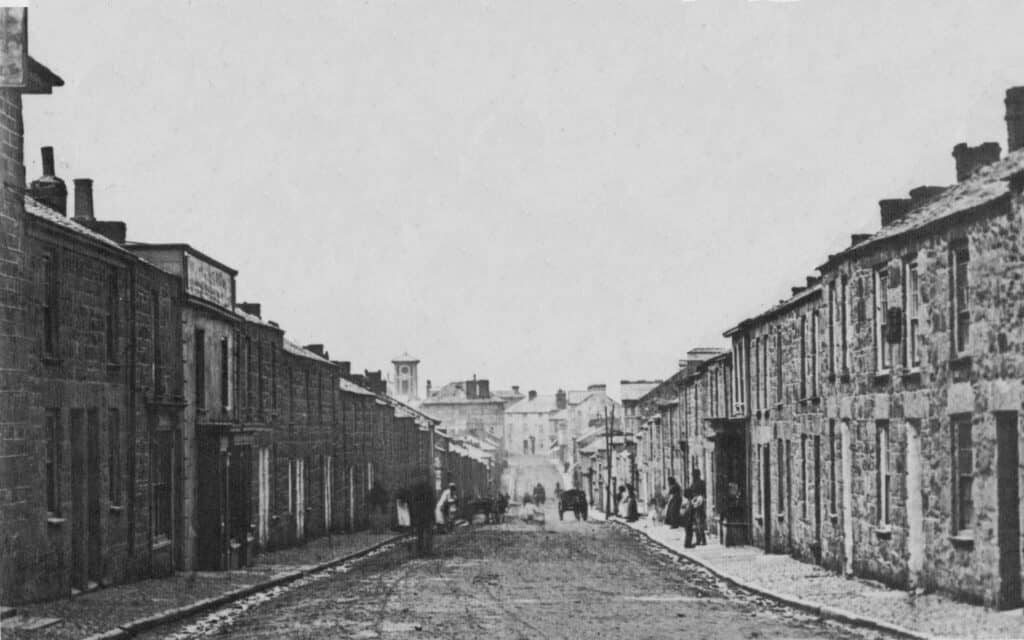
Ellen was the daughter of Benjamin Trythall and Elizabeth Faull, who had married at Treslothan on 8 July 1848 (West Briton and Cornwall Advertiser, 14 July 1848). Like the Vials, the family were mining stock. At the time of his daughter’s marriage to John Vial, Benjamin was a widowed tin miner who worked at Cook’s Kitchen mine on the Great Flat Lode. He witnessed his daughter’s marriage, but was unable to sign the marriage register.
Ellen’s family were as poor as the Vials. It is doubtful Ellen saw much schooling, although she was able to sign the marriage register. Her only brother, James, had been sent out to work on the mines before he was ten, as shown on the 1861 census. Her older sister Mary passed away on 10 November 1863 aged 11 of anasarca (severe swelling in the tissues) after contracting scarlatina. Six years later, Ellen lost her mother too. She died at Ramsgate of stricture of the oesophagus on 5th September 1867 aged 50. Ellen was only about eight years old.
Her father struggled to bring up the family on his own, with his income supported by the wages of his only son James and his daughter, Annie, a domestic servant. His eldest daughter, Elizabeth Jane, kept house for the family. In the autumn of 1877, Annie contracted typhoid fever, and she died on 12 October aged 22 after a five-week battle with the illness.
Perhaps the misery endured in his personal life drove Ben Trythall to seek solace in the bottle, for he was hauled to court twice for being drunk; once in 1877 and fined the sum of 7s and 6d (The Cornish Telegraph, 3 April 1877) and again in 1879, when he had to pay 5s and 11d costs at Camborne Petty Sessions. On that occasion, he was charged with being drunk in Union Street, Camborne, and was reported to have been making a great noise with a mob of boys around him. He claimed that he had only partaken of three glasses of ale, and that he was not drunk, just exhausted, having not taken off his clothes for three weeks. The arresting officer did not believe him in the least (West Briton and Cornwall Advertiser, 17 December 1874).
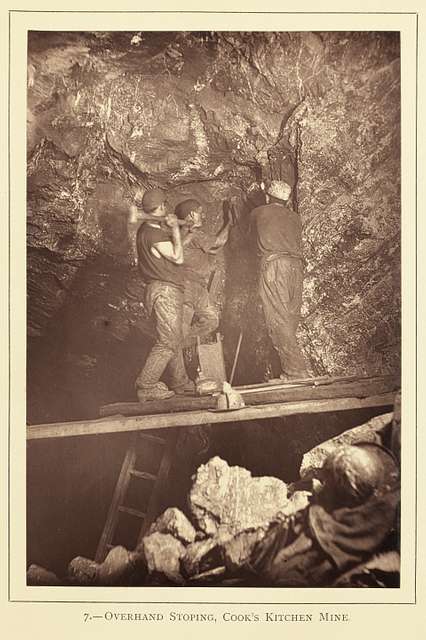
On marriage to Ellen, John moved in with her family at their home in Chapel Street, Camborne, which consisted of her father and unmarried sister, Elizabeth Jane, who was working as a dressmaker. In January of 1881, the couple welcomed a daughter, Annie, named for her aunt who had died ten years previously. Annie was two months old when the census was taken on 3 April that year.
James’s father Samuel, died of certified phthisis at Edward Street, Tuckingmill, on 16 May 1882 aged 61 (Royal Cornwall Gazette, 26 May 1882). In the summer of 1884, James and Ellen welcomed their second daughter, Ellen. Later that year Ellen’s father, ‘Uncle Ben Trythall’, noted as an old Cook’s Kitchen man, died of chronic bronchitis at Chapel Street, aged 63. It is hardly surprising that James and Ellen’s fathers had both succumbed to lung-related ailments. Working underground in ends with bad air impregnated with mineral dust and black powder fumes was highly prejudicial to health. Benjamin’s death was registered by his sister-in-law, Elizabeth Trythall, who was present at his passing, and he was buried on 9 December at Camborne (Cornishman, 11 December 1884).
The Vials in Pachuca, Mexico
It seems that the death of Benjamin Trythall acted as a catalyst for the migration of James from Camborne. Mexico was not such a strange choice, for the Real del Monte-Pachuca area had deep links with Camborne, due to dense migration chains within families that stretched back to the mid-1820s. Indeed, a Michael Trythall from Troon had already worked for the company as a miner, arriving at Vera Cruz on the Packet Steamship Clyde in October 1860 (La Sociedad, 3 November 1860), and he was very distantly related to Ellen.
James appears to have gone ahead to Pachuca, and his wife, two infant daughters and sister-in-law, Elizabeth Jane Trythall, joined him in Mexico, probably in the summer of 1887. A daughter was born in Pachuca in April 1888. The couple were to have at least another four children in Mexico, including Juan Edgar Benjamin Vial known as Johnnie, born on 25 February 1894 at La Buena Esperanza, a mine in the hills north of Pachuca.
Vis-à-vis health and salubrity, Pachuca and district was no better than Camborne, with the ochre-coloured river that ran through the town being little more than an open sewer which stank in the summer, and the town’s water supply was poor until pipes brought in fresh water from a purpose-built dam in the late 1890s. Their eldest daughter Annie died of ‘enfermedad’ (sickness) aged 12 years 5 months in June 1893. Transcriptions of the headstone in the English Cemetery give this as Saturday 11 June, but this is an error. The 11 June was a Sunday. It is more likely to have been Saturday 17 June, as her death was recorded in the civil registry on 19 June 1893. Her brother, William Henry, succumbed to smallpox aged about nine on 1 March 1901.
James soon threw himself into life in his new community. He was a member of the Pachuca Cricket Club, and in December 1887 he played on the Married team captained by J.L. Dunstan, against the Singles team, scoring three runs. An ancestor of mine, Captain John Veall Inch, was one of the two umpires! The game was declared a draw (Cornishman, 6 January 1887). Improved transportation links during the Porfiriato had made travel within Mexico cheaper and speedier, and cricket (and later football) leagues were formed. It seems that cricket in Pachuca was his favourite pastime, for he was regularly mentioned in the Pachuca team (Daily Anglo American, 1 July 1891) and was still playing in it over a decade later. In November 1899, James was a member of Sidney Ludlow’s team and got bowled for a duck by Romilly Thomas on the first innings and made six runs on the second (The Mexican Herald, 6 November 1899).
The Vial family were also staunch Methodists, and in 1899 their children, Johnnie, Maud and Minnie, were welcomed into the Methodist Episcopal Church in Pachuca along with 32 other ‘probationers’, during an event reminiscent of the old chapel revivals of Cornwall. Excitement was mounting in the city as the congregation had quite outgrown the old chapel built in 1876, and construction of a new one able to seat 600 people was soon to be commenced, with $17,000 of the estimated $20,000 required to build it having been raised (in the event it cost nearer $50,000). On completion, it was free of debt, due in large part to the generosity of Cornish community and to the energy of the Rev. Benjamin S. Haywood, and the untiring efforts of the Ladies Aid Society, which had organised bazaars and other fundraising events to meet the building and furnishing costs (The Mexican Herald, 11 November 1899). The chapel opened in July 1901 and had two floors, the upper one for the Cornish congregation and the lower, for the larger Mexican contingent. Its fine tower graces the skyline of the city today.
James had migrated to Mexico to better himself and to secure an improved standard of living for his wife and family, and he rose to the position of manager of the Mina La Buena Esperanza. In 1895, he was down in Mexico City on business from Pachuca (The Mexican Herald, 9 October 1895).
This might have been in connection with a proposed change of career direction, for within twelve months he had left the captaincy of the mine. He purchased a portion of the mountain of San Cristobal situated to the west of the city of Pachuca which, it was reported, was proving a veritable ‘El Dorado’ to him. There he had opened a quarry and was suppling stone to the builders of the burgeoning city. He was said to have been making over $200 per week. His business was clearly booming, for he had acquired more mules and carts, and had built a new family house in the suburbs of the town (The Mexican Herald, 17 January 1896).
In March 1898, he and Ellen went down to the City of Mexico and were expected to spend a few days there (The Mexican Herald, 31 March 1898). They made several such trips as this in the autumn of 1902, staying at the American-style Hotel Guardiola with its Restaurant and Oyster House (The Mexican Herald, 26 November 1902). In the spring of 1903, he booked into the famous Hotel Iturbide (The Mexican Herald, 22 April 1903) and then the Porter’s Hotel with his family (The Mexican Herald, 23 April 1903). All of this was a world away from he and Ellen’s impoverished childhoods in Camborne. Even their daughters, Ellen and Maud, were guests at the Hotel Bazar in May 1904 (The Mexican Herald, 27 April 1904).
James did not forget his humble roots and gave generously to various worthy causes. In 1897, his name appeared in a list of Cornishmen who had given money to the Victoria Jubilee Orphanage Fund. He gave $5 (The Evening Telegram, 6 September 1897), and in 1900, he donated $10,00 to the Transvaal War Fund (The Two Republics, 30 January 1900). This was set up for the relief of persons who were disabled whilst serving in the armed forces of the Crown during the Boer War of 1899-1902. By 1908, he was acting as agent for The Mexican Herald in Pachuca (The Mexican Herald, 25 June 1908). Sadly, his wife Ellen died at Pachuca on 29 March 1914 aged just 54 years.
James and Ellen’s son, Johnnie, also developed a passion for sport. His love was not cricket like his father, but football, a sport the Cornish helped to popularise in Mexico. A football club had been formed around the cricket club members at Pachuca as early as 1901, and a league of association football was set up in 1902 (Schwartz, S.P., The Cornish in Latin America: Cousin Jack and the New World, 2016, pp.542-544). The Pachuca club had a good following, as evidenced by one of its early members, William Blamey, enquiring in 1904 of his brother Francis, resident at Sultepec in the State of México, what he thought about the fixtures placed in ‘Tuesday’s Herald’ (The Mexican Herald newspaper), and that he hoped he ‘would be able to go with us to Puebla on 15th September ‘ (postcard in possession of author).
Johnnie played as a full or half back for the Pachuca football team (The Mexican Herald, 25 October 1914) and on occasion played centre forward (scoring a goal in December 1914 against the Mexico eleven). He also captained the team (The Mexican Herald, 7 and 16 December 1914). In January 1914, playing centre half-back, he was noted to have done some sensational shooting (The Mexican Herald, 5 January 1914).
In 1912 he was photographed with his teammates (middle row, first on left) wearing the Pachuca strip of light blue and dark blue. The colours had been chosen by the club to represent Oxford and Cambridge. Four years later he was dead; a casualty of a war fought in continental Europe.
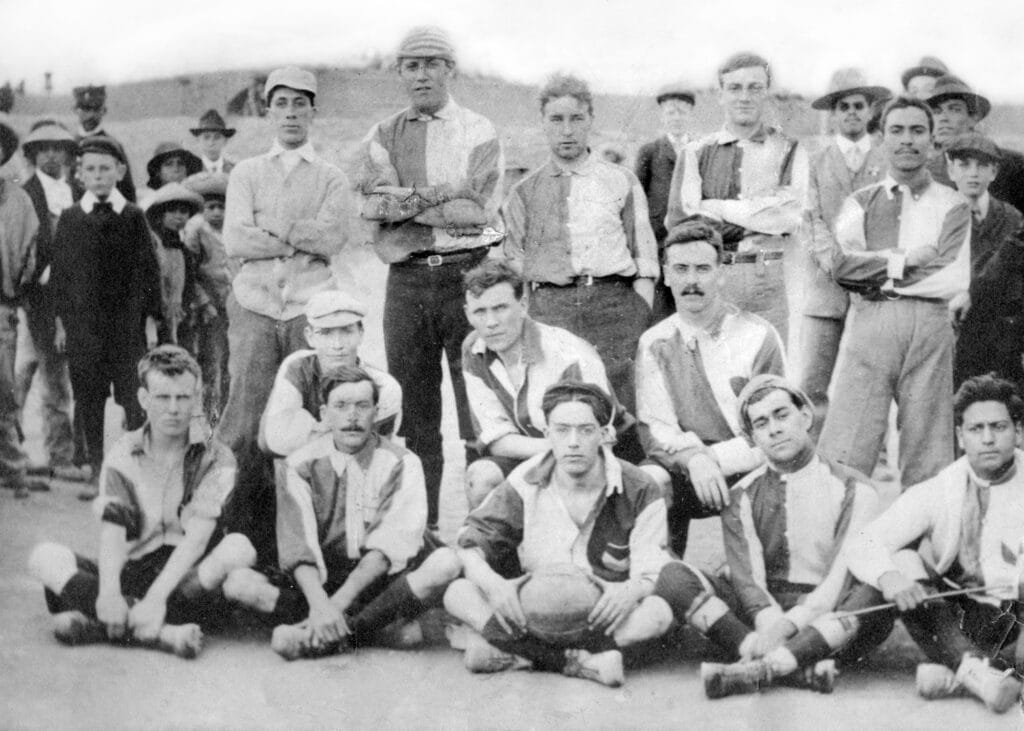
His father’s loyalty to his native country was demonstrated when he gave to the Transvaal War Fund, supporting Britain’s imperial aims in South Africa. Although born in Mexico, Johnnie was a British subject, and he too showed his patriotism to Britain when he answered the call to arms. In common with many other Cornish families in the Pachuca district, the Vials were living a transnational life, maintaining strong family and community links with their place of origin, demonstrated when in 1914, Johnnie travelled to Camborne to sign up for King and Country. There he enlisted in the Royal Horse Artillery and Royal Field Artillery as a gunner.
He gave the ultimate sacrifice for his country when he died in France of his wounds on 5 September 1916 aged 22 years 6 months, having seen action at the Somme. He was buried at the Saint Sever Cemetery, Rouen, on 6th September 1916. A headstone stating his service number and regiment was erected: 121973, Gunner J.E.B. Vial, Royal Field Artillery 6th Heavy Trench Mortar Bty.
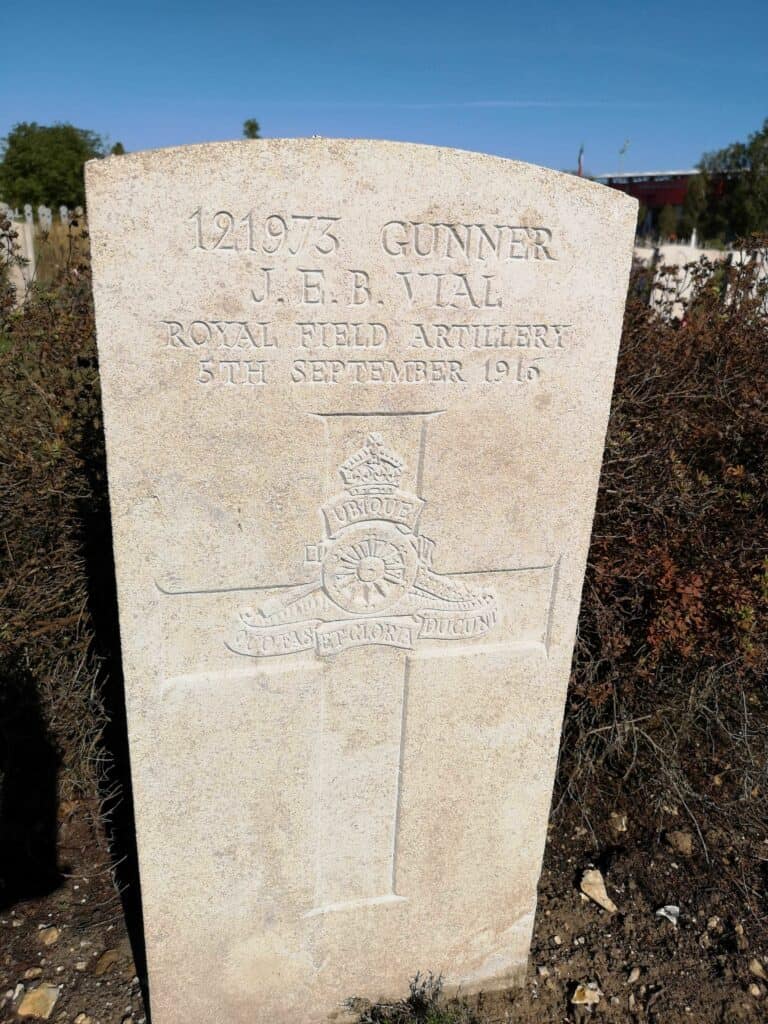
However, the tragedy in the Vial family did not stop with Johnnie. His brother Samuel Arthur also enlisted as a gunner in the Royal Garrison Artillery (service number 146543) and was killed in action on 17 August 1917. He is buried in the same cemetery as his brother at Rouen.
Johnnie is remembered in the English Cemetery of Real del Monte where his parents, siblings and aunt also repose. A badge of the Royal Field Artillery was added to his mother’s grave with the words, Pte. John Vial, 5 September 1916, aged 22 years 6 months died of wounds at the Somme, buried at Rouen 6th September 1916. Arthur was commemorated on the now missing British War Memorial in the shape of a Celtic Cross that was erected in the grounds of the Tlaxpana Cemetery in the City of Mexico in March 1927.
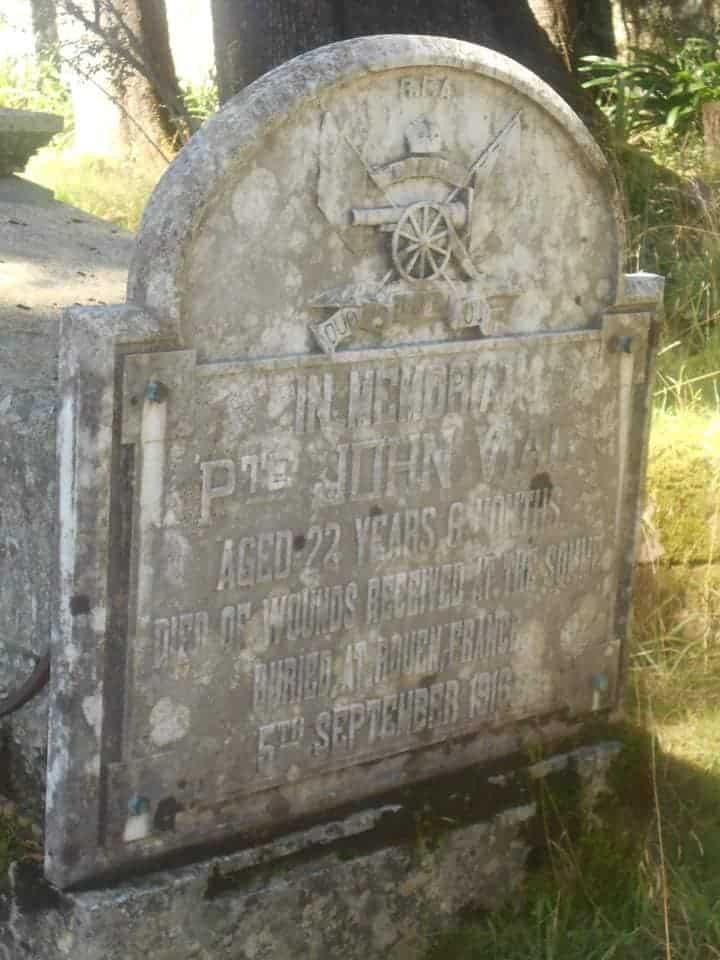
James Vial made a visit to the USA accompanied by his daughter, Maud and her two children in 1919. The family passed through the Laredo border crossing, Texas, on 4 November 1919. Maud settled in the USA with her husband, Stoke-on-Trent native, John Frederick Codie, whom she had married in Pachuca in March 1912.
James returned to Pachuca where he died on 30 September 1920 of mitral insufficiency (a form of valvular heart disease). His death details note that he was a miner by trade, so he appears to have given up the quarry business and gone back to mining at some point. He was interred at the English Cemetery, Real del Monte, but not in the same grave as his wife, Ellen. There is a headstone on which is inscribed: In loving memory of James Thomas Vial born at Camborne, Cornwall, England died at Pachuca, Hidalgo, Mexico Wednesday September 20th 1920. The headstone sports masonic insignia, denoting that he was a Freemason, as were many of his fellow Cornishmen.
However, the date of death has again either been inscribed incorrectly on the headstone, or transcribed incorrectly, for the 20 September fell on a Monday, not a Wednesday, and the civil registration record of his demise clearly notes the 30 September, which was a Thursday.
Ellen’s spinster sister, Elizabeth Jane Trythall, who accompanied her and her children to Mexico, died on Friday 13 September 1918 at Pachuca. She is buried in the English Cemetery in a marked grave inscribed ‘In loving Memory of Elizabeth Jane Trythall’, and which bears a Latin Cross.
So, there is a small cluster of people very distantly related to me at the Real del Monte English Cemetery, which gives this special place an added poignancy. I shall be sure to place some flowers on their memorials when I return to the Real this October (2024).
© Dr Sharron P. Schwartz
Some corner of a foreign field that is forever Cornwall:
The Vials of Camborne
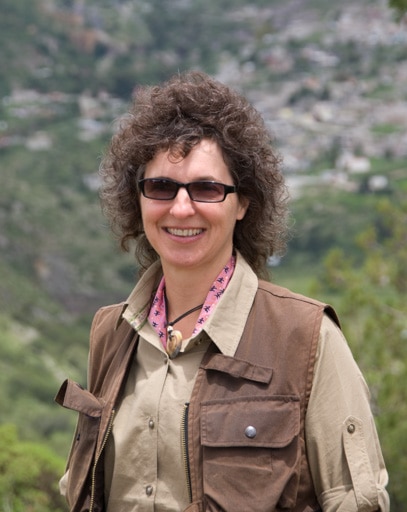
Dr. Sharron Schwartz
Specialist in Cornish Mining Migration and transnational communities
